Chaiyakarn Soontharotoke, MD, Neonatal-Perinatal Medicine
'Why don't you call me Chai?'
"55 years now. I am a medical school graduate from Thailand. To come to the United States to train, you are required to be certified by the Educational Commission for Foreign Medical Graduates (ECFMG). After I completed the ECFMG, I did my internship in 1968 at Uniontown Hospital in Pennsylvania, 56 miles from Pittsburgh.
In 1969, I was applying to a lot of places for residency training. I came to Saginaw for an interview for what was then Synergy Medical Education Alliance. I remember the physicians being so nice. Dr. William Bow picked me up at a little airport and took me out for dinner and said, ‘Hey, come to Saginaw.’ Saginaw General Hospital accepted me to train in the Pediatric department.
All medical residency programs start on the first of July, even today. So, on the 28th of June, three days before July, I drove from Pennsylvania and arrived around nine o'clock at night, parked the car, and walked in the front doors of Saginaw General.
I met the operator and gave her my name, Chaiyakarn Soontharotoke. She said, ‘Doctor, I cannot page your long last name.’ This was back when everything had to be typed in before cell phones. So, I said, ‘Why don’t you call me Chai?’
That was it— to this day, nobody in the state of Michigan knows me as anything besides Dr. Chai."
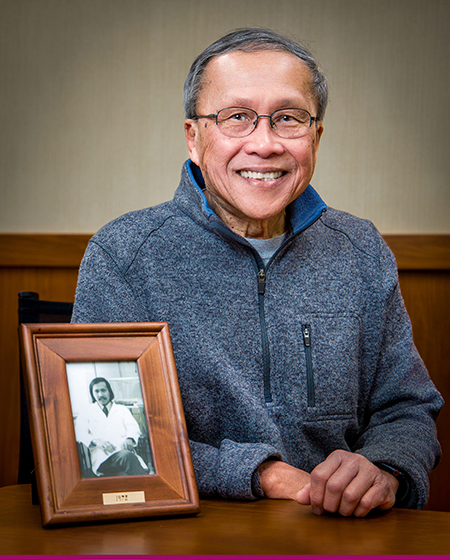
Pictured: Dr Chai with Photo from 1972
Neonatology training
"Back then, we didn’t have all these buildings. Today, the hospital is like a big mansion. When I started my Pediatric residency training at Saginaw General, we had nine pediatricians. One of those pediatricians was Dr. Bob Heavenrich, who later served as the President of the American Academy of Pediatrics—one of the top providers in the country.
After two years and some good training in Saginaw, Dr. Heavenrich called the University of Michigan and spoke to the chief at the time—he said, ‘Why don’t you take Chai for your Pediatric program?’ I didn’t apply for anything; it was destiny that I went there.
1971 was the first year the University of Michigan offered the newborn intensive care specialty program. I was supposed to be trained in Pediatrics, but U of M needed house staff for Neonatology training. By luck, they used me as a trainee.
Good people taught me at U of M during my Neonatology fellowship. I worked with doctors there who discovered what to put in newborn medicine. As a trainee, I conducted research and went to Saginaw to collect amniotic fluid samples from newborn babies, then took them 72 miles back to Ann Arbor to be tested. From these samples, you could see what babies would have trouble because of premature lungs.
While I was working in Ann Arbor, an obstetrician-gynecologist in Saginaw County, Dr. Gerald Sieggreen, invited one of his instructors from Milwaukee Medical School, Dr. Louis Gluck, to come give a lecture in town. Dr. Gluck, who trained in London, England and started a neonatal unit in Milwaukee, was really known for advancing newborn medicine in the United States.
During his visit to Saginaw, the obstetrician told Dr. Gluck, ‘Dr. Chai is in Ann Arbor. Why don’t you take him for training?’ He agreed, so I moved to Milwaukee, Wisconsin for my second year of Neonatology fellowship training. "
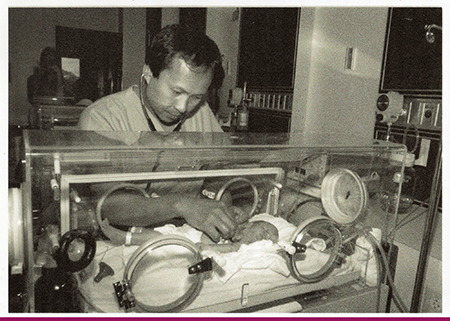
Pictured: Dr Chai with Newborn in Isolette
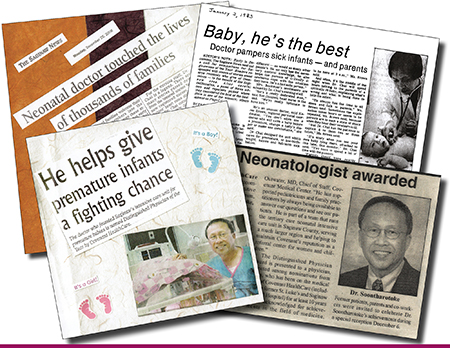
Pictured: Newspaper Collage featuring Dr Chai
Dr Chai brings Neonatology to Saginaw
"After completing my Neonatology fellowship in Wisconsin, a Pediatrician at Saginaw General Hospital named Dr. Eugene Rank said, ‘Hey, you know we could really use the neonatal specialty here in Saginaw.’ At that time, nobody had a neonatal intensive care unit in the region.
I wasn’t yet employed by Saginaw General or any of the other local hospitals, so to come back to town, I had to find a way to make a living. So, in 1973, a group of local pediatricians met and wrote a letter that recommended bringing me to the area so a newborn care system could be developed in Saginaw.
I think it was destiny. This didn’t happen because I am smarter than anyone—I just happened to be in the right places at the right moments.”
The letter states:
October 10, 1973
DEAR COLLEAGUE:
Doctor Chai (Chaiyakarn Soontharotoke) has begun the private practice of neonatology in Saginaw. He has just finished two years of neonatology fellowship. His first year of fellowship was at the University of Michigan Medical School; the second at Milwaukee County General Hospital, Milwaukee, Wisconsin. He plans to limit his practice to neonatal care and will not develop a private practice outside the hospital setting.
A meeting, attended by all local pediatricians, was held October 3, 1973 to discuss the mechanics of patient referral to Doctor Chai. Because the practice of neonatology has become such a time consuming and highly specialized sub-specialty of pediatrics, it is felt that a person of his training is greatly needed in this community. In order to keep him here he naturally has to have patients. Some suggestions that may generate an inflow of patients to him are as follows.
- Doctor Chai will work with newborn services, namely, the nurseries at Saginaw General and St. Mary’s Hospitals.
- All “staff” newborn patients will be referred to Doctor Chai for examination and for neonatal care while these patients are in the hospital. Since he is receiving no salary subsidy, it is hoped that this core croup of patients will serve as a base source of income.
- Doctor Chai will be available for all newborn delivery room emergencies and it is recommended that these referrals be made directly to him. Restated, if the physician in attendance at delivery of a distressed infant feels that the infant is in need of urgent, emergent or special neonatal care, referral to Doctor Chai should be initiated by the physician attending the baby.
- Babies not requiring the type of care suggested in the preceding paragraph should be referred to the physician chosen by his parents for his post delivery care. If these babies should develop problems requiring special neonatal care, referral to Doctor Chai should be initiated by the physician attending the baby.
- On discharge from the hospital, those babies cared for by Doctor Chai will be referred back to the physician chosen by the parents for well baby care.
It is our intent that a system be developed in Saginaw to provide optimal care for the newly born. We feel that the addition of Doctor Chai to the Pediatric Team is a major move toward that goal.
Sincerely,
William A. Bow, M.D.
Charles W. Cory, M.D.
Jerry J. Evans, M.D.
Robert M. Heavenrich, M.D.
Rudolph M. Jarvi, M.D.
William G. Mason, M.D.
Eugene Rank, M.D.
Ivan J. Roggen, M.D.
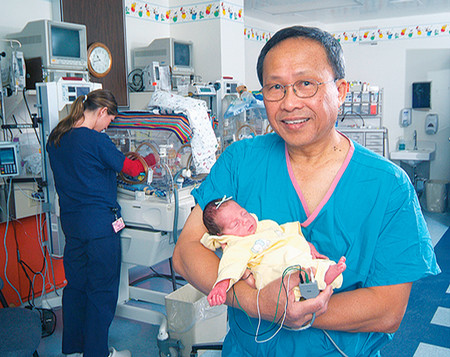
Pictured: Dr Chai Holding a RNICU Baby (2007)
Founding the Special Care Nursery/RNICU
"In 1973, everybody wanted to have a neonatal unit—the Upper Peninsula, Traverse City, Lansing, Ann Arbor, and Grand Rapids... But you couldn’t just build a unit—you were required to have a certificate of need from the State of Michigan.
Here in Saginaw, it was the family doctor and obstetrician that would deliver babies, and if a baby was sick, it had to remain at the hospital where it was born, since there was no specialty unit in the area. At that time, we didn’t have the luxury of a neonatal unit. So, I would go by ambulance to pick up sick babies to transport from Midland, Bay City, Tawas, Oscoda, West Branch, and other surrounding areas to bring to Saginaw General.
That year, I accompanied Dr. Eugene Rank from Saginaw General to testify in Lansing to describe our need for a neonatal unit in Saginaw. It was scary as a 30-year-old to testify. There was a very serious doctor for the State who asked, ‘Dr. Chai, do you really plan to go to Saginaw?’ I said, ‘Yes, sir.’ That’s how it happened—that is why the Special Care Nursery came to Saginaw General 50 years ago.
High risk patients were able to come to Saginaw General once the Special Care Nursery was established. The Nursery on the 4th floor was tiny and had only a couple beds when we started it in 1974. When it first opened, you had to monitor the oxygen manually. At that time, we didn’t have sensors to put on a baby’s skin to read. Nowadays, there is a lot more technology to help monitor and provide care.
Today, Covenant HealthCare has a Level II Regional Neonatal Intensive Care Unit, which is much more advanced and larger, with 55 beds for infants.
We now have a good connection in all the region because of the way we treated providers and patients. We didn’t just take care of the babies—we would go back and communicate with other hospitals and caregivers. We also started a free follow-up care clinic for babies at Saginaw General.
The merger between St. Luke’s Hospital and Saginaw General that took place in 1998 was really between the businesspeople. But I’m glad we merged. We created a good referring system in the region.
Some of my patients still keep in touch. I was most recently invited to a graduation of one of my RNICU patients. The parents wrote me a beautiful letter that she’s going in the specialty, studying medicine and will attend nursing school. She was born at 23 weeks maturity, weight 1 pound and 6 ounces. My son, Adam, took me to the graduation party. It was a full circle moment and a special honor to be thought of after all these years.
Again, I think it was destiny that I ended up here."
—Dr Chai - Chaiyakarn Soontharotoke, MD
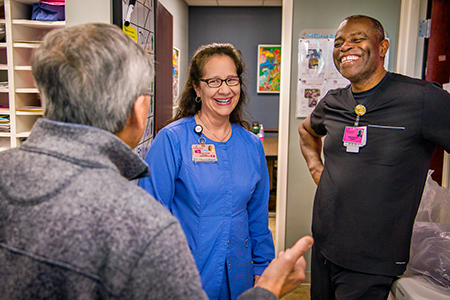
Pictured: (L-R) Dr Chai, Rebecca Schultz and Dr Thurin
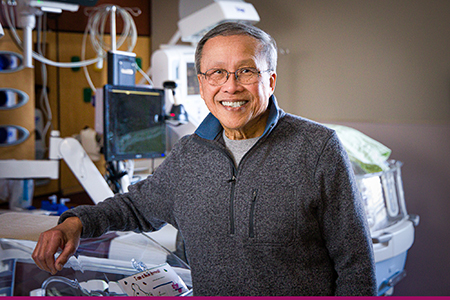
Pictured: Dr Chai (Chaiyakarn Soontharotoke, MD)
In 1998, two long-standing Saginaw based hospitals, Saginaw General Hospital (est. 1886) and St. Luke’s Hospital (est. 1887) merged to form Covenant HealthCare. We’re sharing stories in honor of 25 extraordinary years as Covenant. #25Years25Stories